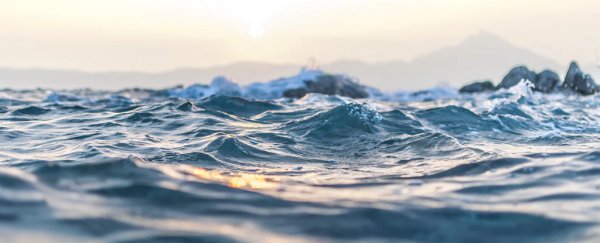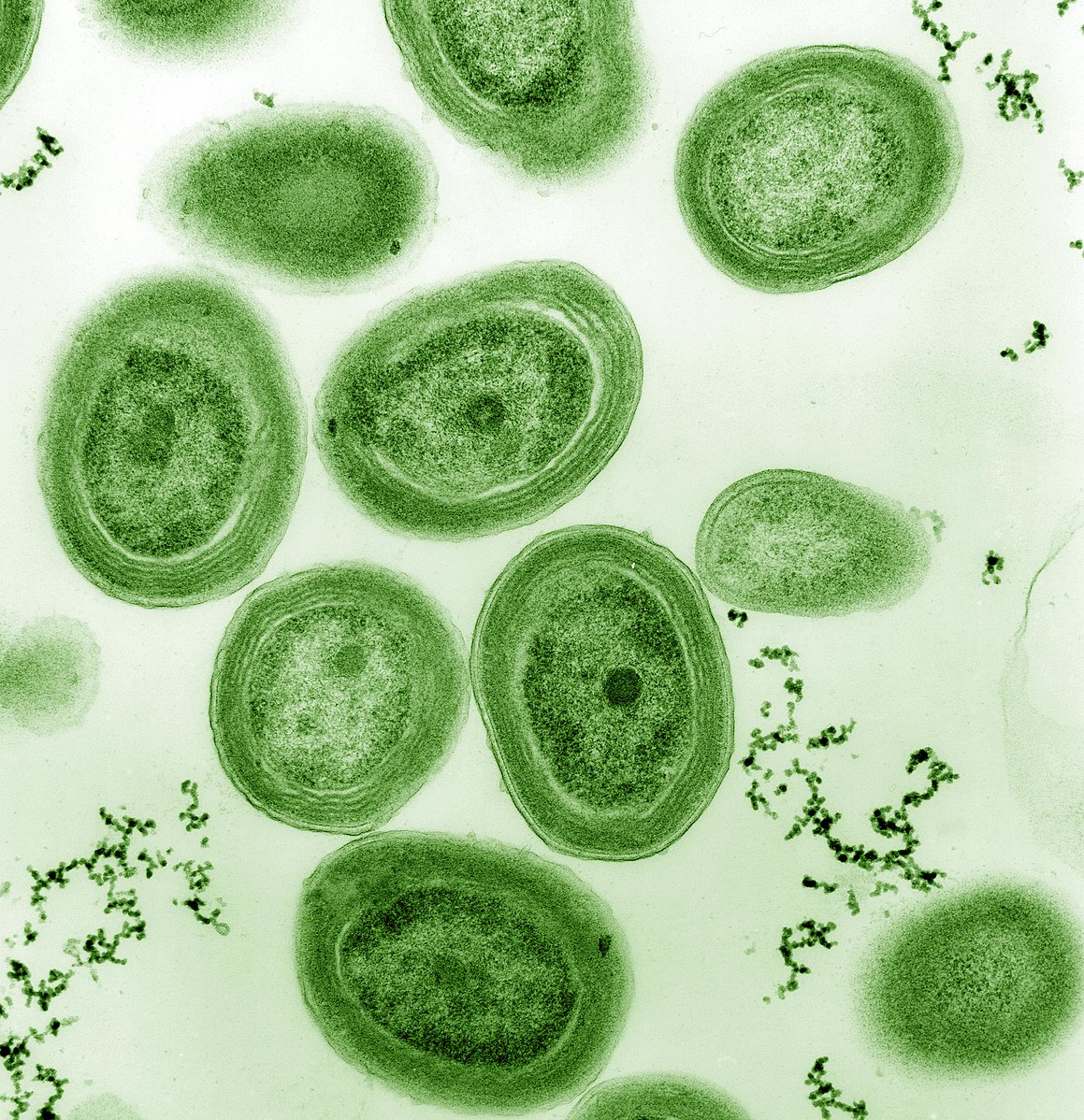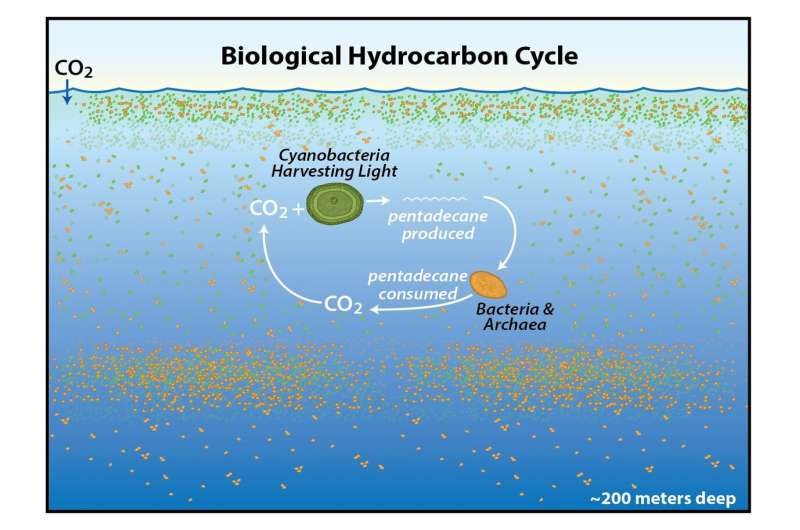"By carefully studying and analyzing emission features from G+0.693-0.027, Rivilla and his colleagues identified a range of nitriles, including cyanic acid, cyanoallene, propargyl cyanide, and cyanopropyne. They also made tentative detections of cyanoformaldehyde, and glycolonitrile."Previous observations of G+0.693-0.027 revealed the presence of cyanoformaldehyde, and glycolonitrile. This suggests that nitriles are among the most abundant chemical families in the Milky Way, and that the most basic building blocks for RNA can be found in the clouds that give birth to stars and planets." (source link here)
 |
Above: A species of the globally distributed marine cyanobacteria, Prochlorococcus. | (Luke Thompson, Chisholm Lab/Nikki Watson, MIT) |
"Valentine explains the cyanobacteria likely use pentadecane as a stronger component for highly curved cellular membranes, like those found in chloroplasts (the organelle that photosynthesise)."The cycle of pentadecane in the ocean also follows the diel cycling of these cyanobacteria – their vertical migration in the water in response to changes of light intensity throughout a day."Together, these findings suggest the cyanobacteria are indeed the source of the biological pentadecane, which is then consumed by other microorganisms that produce the carbon dioxide the cyanobacteria then use to continue the cycle."
- Evolution evolves using the organic material available to it.
- Earth, with its variety of biological life forms, would not be unlike other planetary ecologies holding similar ecological life forms found in earth's galaxy.
- Humanity, though unique to other mammalian animal species, is not unlike the Earth's - nor the Milky Way's - galactic pre-biotic life forms. That is, the RNA building blocks of homo sapiens will share similar RNA building blocks with every life form on Earth.
- As pertaining to the Christian faith, when the God of Genesis created life, God had already created the possibility for life in earlier forms of evolutionary molecular compositions found in the interstellar clouds of astrochemistries of the Milky Way.
- And further, that man is not only of the Earth - but also of the Milky Way. That humanity is deeply connected to a vastly greater whole than it could have imagined in the church's simplified metaphysical and theological cosmologies.
- That this impregnated "universal whole" bespeaks a far deeper and more intimate relational connectivity to all things beyond ourselves, our species, or our mammalian forms. And from all things humanity is reflected back to it's ecological biospheres of primal matter to the very roots of our earlier primal environments.
- That humanity, no less than the Earth, each deeply reflects the other; are intimately connected with the other; must thrive and nurture with one another; and will always exist be in cooperative arrangements of symbiance, balance, rhythm, and harmony with one another. This is yet another fundamental of processual ecologies.
- And when those panmutual ecological harmonies break, which they will as a processual result of amalgamation between actual and non-actual entities, than a normal resulting probability of consequence and random chaotic occurrence will always move towards the re-establishment of primal linkages to its greater processual and panconnective ecological wholes inhabited by the necessity for evolutionary balance, nurture, rhythm, and harmony, as a fundamental of processual ecologies.
- This then speaks to the Whiteheadian philosophy of organism later names "process philosophy" and shown in evolutionary action. And when brought from the metaphysical sphere of cosmology to the theological sphere of process theology will further describe creation, such as the Christian one, as a processually-based cosmology never whole, or complete, in itself but ever in turbulent motion.
- Lastly, here is an instance of a so named "process-based" Christian theology making use of perceptive contemporary philosophies and sciences which would break from the church's earlier metaphysical and scientific models no longer pertinent to the contemporary world as we currently understand it. That no philosophy or theology is ever complete in itself though it may rest on integral constructions of metaphysics describing the natural and supernatural elements of creative imagination and speculation.
 |
| (Anastasia Taioglou/Unsplash) |
In the awful wake of an oil spill, it's typically the smallest of organisms who do most of the cleaning up. Surprisingly, scientists know very little about the tools these tiny clean-up crews have at their disposal.
But in a study published last year, researchers uncovered a completely unknown cycle of natural hydrocarbon emissions and recycling facilitated by a diverse range of tiny organisms – which could help us better understand how some microbes have the power to clean up the mess an oil spill leaves in the ocean.
"Just two types of marine cyanobacteria are adding up to 500 times more hydrocarbons to the ocean per year than the sum of all other types of petroleum inputs to the ocean, including natural oil seeps, oil spills, fuel dumping and run-off from land," said Earth scientist Connor Love from the University of California, Santa Barbara (UCSB) back in February 2021.
But unlike more familiar human contributions of hydrocarbons into our ocean, this isn't a one-way, local dump.
These hydrocarbons, primarily in the form of pentadecane (nC15), are spread across 40 percent of Earth's surface, and other microbes feast on them.
They're constantly being cycled in such a way that Love and colleagues estimate only around 2 million metric tons are present in the water at any one time.
"Every two days you produce and consume all the pentadecane in the ocean," Love explained.
 |
| Above: A species of the globally distributed marine cyanobacteria, Prochlorococcus. | (Luke Thompson, Chisholm Lab/Nikki Watson, MIT) |
Today, humanity's hydrocarbon footprints can be found in most aspects of our surroundings. We emit these molecules composed of only carbon and hydrogen atoms in many ways – the bulk through extraction and use of fossil fuels, but also from plastics, cooking, candles, painting, and the list goes on.
So it probably shouldn't be a huge surprise that traces of our own emissions drowned out our ability to see the immense hydrocarbon cycle that naturally occurs in our oceans.
It took Love and colleagues some effort to clearly identify this global cycle for the first time.
Far from most human sources of hydrocarbons, in the nutrient-poor North Atlantic subtropical waters, the team had to position the ship they sampled from to face the wind, so the diesel fuel that also contains pentadecane did not contaminate the seven study sites. No one was permitted to cook, smoke or paint on deck during collections.
"I don't know if you've ever been on a ship for an extended period of time, but you paint every day," explained Earth scientist David Valentine from UCSB.
"It's like the Golden Gate Bridge: You start at one end and by the time you get to the other end it's time to start over."
Back on land, the researchers were able to confirm the pentadecane in their seawater samples were of biological origin, by using a gas chromatograph.
Analysing their data, they found concentrations of pentadecane increased with greater abundance of cyanobacteria cells, and the hydrocarbon's geographic and vertical distribution were consistent with these microbes' ecology.
Cyanobacteria Prochlorococcus and Synechococcus are responsible for around a quarter of the global ocean's conversion of sunlight energy into organic matter (primary production) and previous laboratory cultivation revealed they produce pentadecane in the process.
Valentine explains the cyanobacteria likely use pentadecane as a stronger component for highly curved cellular membranes, like those found in chloroplasts (the organelle that photosynthesise).
The cycle of pentadecane in the ocean also follows the diel cycling of these cyanobacteria – their vertical migration in the water in response to changes of light intensity throughout a day.
Together, these findings suggest the cyanobacteria are indeed the source of the biological pentadecane, which is then consumed by other microorganisms that produce the carbon dioxide the cyanobacteria then use to continue the cycle.
 |
| Earth's natural hydrocarbon cycle. (David Valentine/UCSB) |
Love's team identified dozens of bacteria and surface-dwelling archaea that bloomed in response to the addition of pentadecane in their samples.
So they then tested to see if the hydrocarbon-consuming microbes could also break down petroleum. The researchers added a petroleum hydrocarbon to samples increasingly closer to areas with active oil seepage, in the Gulf of Mexico.
Unfortunately, only the sea samples from areas already exposed to non-biological hydrocarbons contained microbes that bloomed in response to consuming these molecules.
DNA tests showed genes thought to encode proteins that can degrade these hydrocarbons differed between the microbes, with a contrast evident between those that ate biological hydrocarbons and those that devoured the petroleum-sourced ones.
"We demonstrated that there is a massive and rapid hydrocarbon cycle that occurs in the ocean, and that it is distinct from the ocean's capacity to respond to petroleum input," said Valentine.
The researchers have begun sequencing the genomes of the microbes in their sample to further understand the ecology and physiology of the creatures involved in Earth's natural hydrocarbon cycle.
"I think [these findings reveal] just how much we don't know about the ecology of a lot of hydrocarbon-consuming organisms," said Love.
This research was published in Nature Microbiology.
A version of this article was first published in February 2021.
